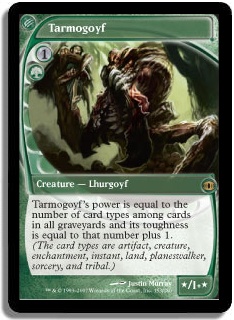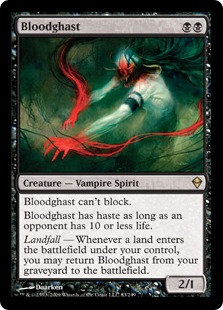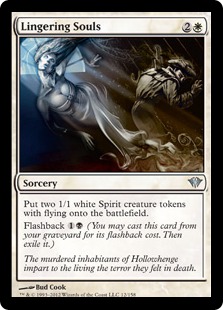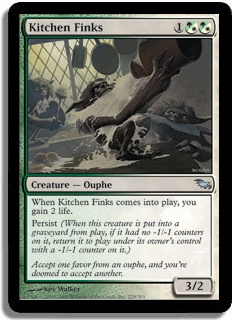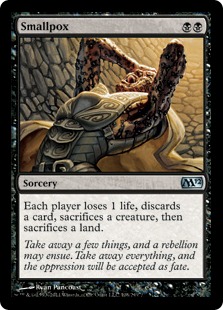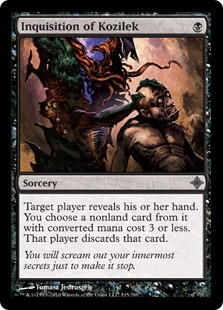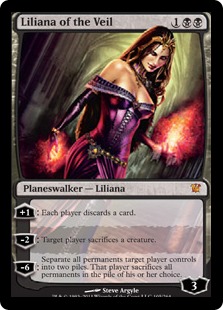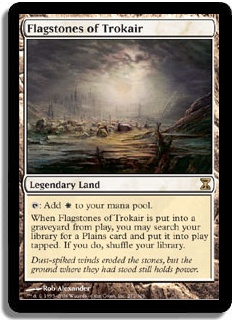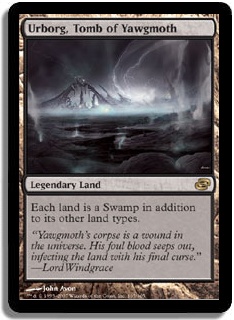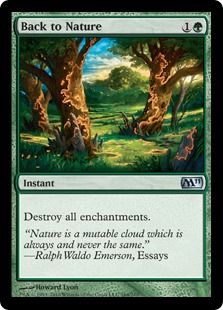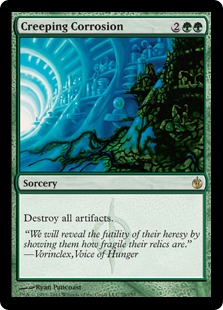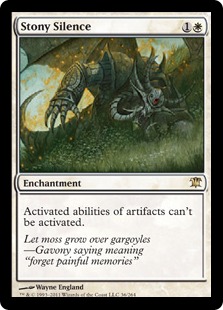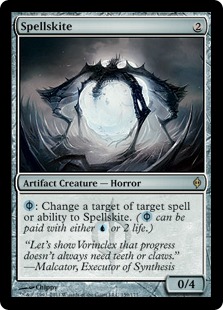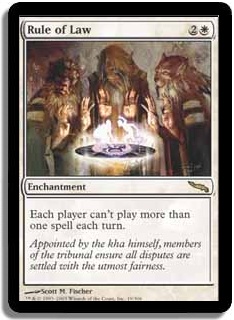Modern, if you didn’t already know, is one of my favorite formats for many reasons. It has an extraordinarily large card pool, making it significantly different than Standard with a wider range of playable decks and interactions. When a new set is released, I always look for cards that have the potential to make significant splashes in Modern. With Modern PTQ season in full swing, I’m constantly working on updating decks and trying to find weaknesses in the format to exploit.
With that said, I think that land destruction is quite good at the moment. Boom / Bust has been seeing a reasonable amount of play in various green-based decks, but it isn’t quite what I thought it would be. You can’t reasonably cast it on turn 2 without damaging yourself significantly or having the nut draw of Deathrite Shaman and two fetchlands (or your opponent uses their fetchland on the first turn). Additionally, when you are on the draw, Boom / Bust can be a little slow thanks to so many Deathrite Shamans running around.
The solution seems clear:
During last year’s Modern PTQ season and throughout the subsequent months, I tried my best to find a way to make Smallpox a good card. I tried everything from Life from the Loam with Raven’s Crime to Geralf’s Messenger and Gravecrawler. I’ve even put it into various builds featuring Seismic Assault and Flame Jab. As you can probably tell, I think I have an unhealthy obsession with this card.
Of course, the card is good, but the real question I have to ask myself whenever I go on a brewing spree is how good? My obvious response is "very," but perhaps I’m a bit biased.
But Smallpox does tend to fix all the problems that Boom / Bust has. Obviously, the decks that utilize it are pretty different in what they’re trying to accomplish, as Jund and Naya are just a collection of powerful cards while a dedicated Smallpox deck tends to be a bit…different.
Without further ado, here is my current Pox list:
Creatures (15)
Planeswalkers (4)
Lands (23)
Spells (18)

There are some small problems with the deck I’m still trying to work out, but I think this list is a great start. You have the same type of disruption as Jund with the added bonus of being able to completely annihilate certain opponents with Smallpox. Your Deathrite Shaman into Liliana of the Veil draw is patently absurd, as you can either Edict your opponent or start trimming their hand down little by little. While doing so with Liliana, your set of Smallpox and Thoughtseize continue eliminating their resources until they’re forced to beat you with only the top of their deck.
The Threats
Tarmogoyf is an absolute all-star in this deck, acting as both a brick wall to your opponent’s threats and a solid win condition when your opponent is out of resources. After just a few short turns, your Tarmogoyfs should combine nicely with your Bloodghasts to close out the game. Your opponent’s Lightning Bolts and Lilianas as just laughable and shouldn’t provide them with much defense against your recurring threats.
With so many threats that are actively good with Smallpox, it becomes increasingly difficult to deal with your board as your continuously drain your opponent of their hand and eventually their life. Smallpox attacks their resources like few other cards in Modern, and the added disruption of killing their lands should slow them down long enough for you to take complete control of the game.
And if they start off their early turns with a creature, Smallpox just gets dirty.
With basically every non-combo deck in the format running Deathrite Shaman, you have an actual trump card in the matchups where they’re just trying to one-for-one you to death. When none of your threats are easily answered by these one-for-ones, the increasing card advantage gained by your slew of cohesive cards is just devastating.
Bloodghast looks pretty miserable against a few decks in the format, but it is almost impossible to deal with. Your goal is to leave your opponent without any creatures in play, which ultimately means Bloodghast will be getting through unblocked almost every time. When you can use Urborg, Tomb of Yawgmoth as a way to not fetch lands in the early game, your Bloodghasts become even stronger because you are left with a lot of ways to bring them back in the mid-to-late game.
Lingering Souls was the card that brought it all together.
One of the newer innovations in Jund is an easy fit for this deck. Lingering Souls works wonders with Liliana of the Veil and Smallpox, giving you access to a lot of threats while still being able to gain full value from your disruptive cards. While Lingering Souls is falling out of favor in Jund decks, this means good things for you. When your opponent doesn’t have Lingering Souls, every game against the other fair decks should be pretty easy.
Of course, if they do have Lingering Souls in their deck, we just have to grind through it. Our Edict effects become a little worse, but we can almost always match them with our own Lingering Souls. When we fall too far behind, we end up just having to race with Bloodghast, Tarmogoyf, and Kitchen Finks. Not a great proposition, but a single Lingering Souls will easily put you ahead in this race.
While Kitchen Finks isn’t the greatest card in Modern, it is one of the best men for the job in this slot. I tried Geralf’s Messenger, but I continually found myself wanting to block to make sure I could win the late game. Messenger is pretty awkward and leads to some very unsavory positions, while Kitchen Finks fits perfectly. Kitchen Finks also allows you to play Flagstones of Trokair with very little drawback, making your Smallpoxes that much better.
Kitchen Finks can also gain a significant amount of life in a race. When your opponent is throwing burn spells at your dome, your Kitchen Finks can act as both a clock and a way to buy precious time. In a pinch, it is not unheard of to use your own Abrupt Decays on your Finks to gain life when your opponent is about to kill you with a Bump in the Night or other nonsense.
While I don’t need to go into detail about why Deathrite Shaman is good, I would like to explain why he is in the deck. First of all, there is a bit of tension between Smallpox and Deathrite Shaman, which sucks. However, it is usually pretty easy to play around your own Smallpox, and the times when you can cast a turn 2 Liliana of the Veil against combo or Kitchen Finks against aggro is pretty absurd. He also acts as an additional way to gain life or deal damage depending on what position you’re at in a game.
While Deathrite Shaman isn’t necessarily at its best in this deck thanks to Smallpox, I do think it is definitely worth the investment. With so many lands going to the graveyard on both sides of the field, it is rare that he doesn’t tap for mana. He is also one of the best ways for you to disrupt opponents who tend to use their graveyard more than most.
The Answers
Abrupt Decay, while not so great in Standard, is just awesome in this deck. You don’t have access to Lightning Bolt, which is one of the premier removal spells in Modern, but Abrupt Decay deals with most of the problems that would otherwise be annoying. Splinter Twin decks have few answers and very little time to assemble their combo. The pressure on their resources via Liliana of the Veil and Smallpox force them into a corner where they usually have to "go for it" or have their combo stripped from their hand. When this is the case, Abrupt Decay ensures that you won’t get blown out by a timely topdeck.
Basically every deck in the format has a great target for Abrupt Decay, from Tarmogoyf to Cranial Plating and even the occasional Goblin Electromancer. Its versatility makes Abrupt Decay one of the best possible solutions to almost any problem you could conceivably have!
This is the reason the deck exists. Without Smallpox, we would just be playing Jund, but I think that the land destruction and hand disruption aspects of Smallpox are just absurd at the moment. With so many decks relying on developing their resources in the early turns of the game, a timely Smallpox can basically end the game on the spot. Of course, they will always have a few turns to try to draw out of it, but any amount of stumbling will almost assuredly mean game over.
With so many of the fair decks playing their own Deathrite Shamans, it isn’t hard to get full value out of Smallpox, and it can be incredibly difficult for them to play around it.
Much like our Jund brethren, we’re attempting to pick our opponents apart from the beginning of the game. However, we take this disruption a step further and continue our attack their resources until they’re left with nothing.
If only we had access to Wasteland…
Almost every deck in Modern is focused on building to an ultimate end game where their collection of spells gets them to some combo or another. Luckily for us, a lot of those combos rely on creatures. While Abrupt Decay isn’t great at killing Restoration Angel or Kiki-Jiki, it is incredibly difficult for those decks to function without their early mana accelerants. Along with Thoughtseize and Inquisition, the rest of your disruption should bottleneck them.
Liliana is fantastic in Modern. There are few creatures with leaves-play abilities, which means that her Edict effect will almost always be backbreaking. On top of that, very few combo decks can reliably build up enough resources to win through her constant pressure on their hand. Liliana is rarely dead in any matchup, which makes her one of the most valuable cards in the deck in many different situations.
Of course, there are a few lingering problems that she can’t handle that well. Against Splinter Twin decks, her Edict effect is pretty useless, which means that you have to rely much more on hand disruption and hope you can force them to run into Abrupt Decay. Against basically everything else, she’s exactly what you want to be drawing and casting in the early turns of the game.
Since Liliana is so good in the deck thanks to the plethora of "ok to discard" cards, you make opposing Lilianas from other decks look embarrassing. Just savor the look on their face when they use the +1 and you discard a Bloodghast for the first time.
The Mana Base
While the mana isn’t quite perfect, I think that the combination of Smallpox and Flagstones of Trokair isn’t just cute—it’s busted. While your opponent is floundering to rebuild their resources after your Smallpox, you’re casually curving into Liliana on the third turn to put the game away. Flagstones also gives you a cool way to interact with Bloodghast, as you can discard the Bloodghast to Smallpox, sacrifice the Flagstones, and then bring back the Bloodghast in the same instance with the trigger from Flagstones.
Along with Urborg and Fetid Heath, Flagstones into Smallpox is a common occurrence on turn 2!
Yes, this land is legendary. Playing too many can have grave consequences with awkward draws. However, playing more ensures that you will draw them more often (obviously), and you have the option to discard or sacrifice extra copies to both Smallpox and Liliana of the Veil. Urborg teams up nicely with Flagstones to do some nasty things with Smallpox, which shouldn’t be overlooked.
Urborg also allows you to sandbag your fetchlands so that you can use them later on to recur Bloodghast. It gives you a way to tap your lands for mana without taking damage against decks like Burn, which can be very important when most games end with you sitting on a "healthy" two to four life.
The Sideboard
Yes, Slippery Bogle is a deck. Yes, this is the best answer I could come up with. With Smallpox and Liliana of the Veil at your disposal, G/W Auras shouldn’t be that hard to deal with, but I like having a few answers to their nut draws. Their Dryad Arbors can protect their more important threats from your Edict effects, so having Back to Nature as a backup plan is important. Abrupt Decay helps a lot in this matchup as well since it can effectively neuter their larger creature by killing either Ethereal Armor or Daybreak Coronet.
The main draw of this deck is that it is actively good against Jund, which is currently the frontrunner of the format. There are some fringe decks in Modern that can give you problems though because they aren’t trying to play fair. Affinity is one of those decks, but luckily you have access to a lot of cards that actively punish them for being such a linear aggressive deck. While Creeping Corrosion will usually just hammer the nail home, Stony Silence ensures that your stranglehold of disruption will put them out of the game and give you the time you need to find your answers.
Both of these cards are geared towards Affinity, but Stony Silence has the added benefit of being awesome against G/R Tron. Their deck is full of wonky artifacts that cycle and things like Oblivion Stone and Relic of Progenitus, which are really bad for you. Stony Silence shuts down basically everything, giving you enough time to strip their hand of relevant cards and Smallpox them out of the game.
Spellskite is actually one of the most important sideboard cards in Modern at the moment since it is so powerful against so many decks. Slippery Bogle and Splinter Twin are both prominent players in the current format, and Spellskite acts as a dagger to both while also being pretty solid against Burn. Even though you can’t actually pay for his ability with blue mana without a Deathrite Shaman in play, you can deter some of the damage from burn spells as well as block Goblin Guide and friends.
This card is designed to stop Storm decks from going off. With your early disruptive package and Liliana to pressure their hand, Rule of Law should shut them down completely. Of course, they do have things like Echoing Truth to bounce it, but they will have to draw those as well as a way to combo off all while defending themselves from your constant disruption.
…
Modern is a fantastic format that just needs a few tweaks. I love the idea of having so many cards legal in a format since it gives me a lot of room to work with. I can find new combos, new interactions, and build basically whatever deck I want! The only thing to keep in mind is that what you’re doing needs to be powerful because everyone else has access to the same cards!
At the moment, I think that Smallpox directly attacks some of the weaknesses in the format. There aren’t a lot of sources of card advantage, so being able to take advantage of that is pretty important. That’s what Jund does, and we just take it a step further. I’ll be testing out various builds of this deck over the next few days before a live PTQ this weekend. It is a ton of fun and will drive your opponent absolutely mad!
Thanks for reading!
@strong_sad on Twitter
strong sad on Magic Online


